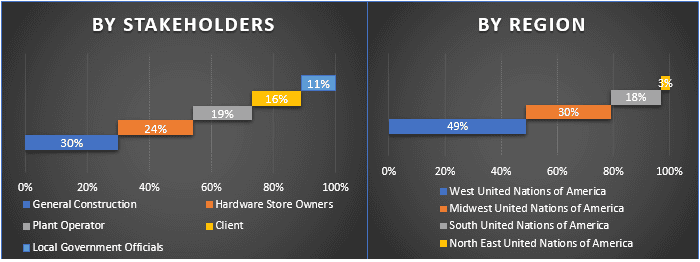- Startseite
- Über uns
- Industrie
- Dienstleistungen
- Lesen
- Kontaktieren Sie uns
USA Markt für Bau- und Möbelbeschläge: Aktuelle Analyse und Prognose (2021-2027)
Schwerpunkt auf Produkttyp (Stahltyp, Kupfertyp, Aluminiumtyp, Sonstige); Anwendung (Schrankbeschläge, Türbeschläge, Fensterbeschläge, Sanitärbeschläge); Endverwendung (Wohnbereich, Nicht-Wohnbereich); Region

Es wird erwartet, dass der USA Builders Hardware Markt die Marktbewertung von mehr als 21 Mrd. US$ im Jahr 2027 übersteigen wird und im Prognosezeitraum (2021-2027) mit einer CAGR von ~4 % wächst. Bauhardware ist eine Gruppe von Metallwaren, die speziell zum Schutz, zur Dekoration und zur Bequemlichkeit in Gebäuden verwendet werden. Bauprodukte machen keinen Teil eines Gebäudes aus, sondern unterstützen es und sorgen dafür, dass es funktioniert. Sie unterstützen in der Regel Einrichtungsgegenstände wie Türen, Fenster und Schränke. Zu den gängigen Beispielen gehören Türgriffe, Riegel, Türscharniere, Schnapper, Briefplatten, Ziffern, Schalterplatten und Türklinken. Bauhardware ist üblicherweise in Stahl, Aluminium, Messing, Edelstahl und Eisen erhältlich. Bekannte Anbieter von Bauhardware gibt es hauptsächlich in China, Mexiko, Indien und teilweise in den USA. Der Begriff Hardware bezieht sich im industriellen Umfeld auf physische, mechanische Teile, aus denen ein Produkt oder eine Anwendung besteht. Dazu gehören kleine, grundlegende Teile, die zum Befestigen, Verstärken und/oder zur Ermöglichung von Teilbewegungen verwendet werden. Hardware-Geräte wie Nägel, Bolzen, Schrauben und Befestigungselemente im Allgemeinen gehören zu den ältesten Hardwaretypen. Diese reichen bis ins alte Ägypten zurück. Sie werden höchstwahrscheinlich schon vorher verwendet.
Die Covid-19-Pandemie hat die Materialknappheit deutlich reduziert, die nun weiter verbreitet ist als zu irgendeinem Zeitpunkt, seit die NAHB in den 1990er Jahren begann, das Problem im Rahmen ihrer Umfrage für den NAHB/Wells Fargo Housing Market Index (HMI) regelmäßig zu verfolgen. Als Reaktion auf spezielle Fragen in der Umfrage berichteten über 90 % der Bauherren, die das betreffende Produkt kaufen, über Engpässe bei Geräten, Bauholz und OSB. Genau 90 % gaben an, dass es einen Mangel an Sperrholz gebe, und fast genauso viele (87 %) gaben an, dass es einen Mangel an Fenstern und Türen gebe. Die Engpässe sind nicht nur äußerst weit verbreitet, sondern auch äußerst breit gefächert. Von den zwei Dutzend Artikeln, die in der Mai-Umfrage 2021 aufgeführt wurden, wurden 12 weitere von mindestens 70 % der Bauherren als Mangelware eingestuft. Insgesamt wurden 16 von über 60 Prozent als Mangelware eingestuft und 21 von über 50 Prozent. Alle zwei Dutzend wurden von mindestens 43 Prozent der Bauherren, die den Artikel kaufen, als Mangelware eingestuft. Als die HMI-Umfrage das Thema zuletzt im Juni 2020 behandelte, berichteten im Gegensatz dazu weniger als 40 Prozent der Bauherren über einen Mangel an einem der aufgeführten Produkte und Materialien.
Top Gründe für die Renovierung von Eigenheimen im Jahr 2018

Hardware Distributors, Inc., Johnson Bros. Metal Forming Co., Strybuc Industries, Bermar Associates, Inc., Kroh-Wagner, Inc., Hi-Tech Fasteners, Inc., Freres Building Supply, Nova Fasteners Co., Inc., Gasket Manufacturing Engineering Inc. und Addison Building Materials sind einige der wichtigsten Akteure auf dem USA Builders Hardware Markt. Mehrere M&A-Transaktionen sowie Partnerschaften wurden von diesen Akteuren eingegangen, um Kunden mit Hightech- und innovativen Produkten/Technologien zu unterstützen.
Im Bericht dargestellte Erkenntnisse
"Unter den Produkttypen hält das Segment Stahl den größten Anteil"
Basierend auf dem Produkttyp ist der USA Builder's Hardware Markt in Stahl, Kupfer, Aluminium und andere unterteilt. Stahl bietet Architekten die Freiheit, in verschiedenen Texturen, Farben und Formen zu entwerfen. Stahl bietet eine Kombination aus Festigkeit, Haltbarkeit, Formbarkeit, Schönheit und Präzision und gibt einem Architekten größere Parameter, um seine Ideen zu erforschen. Aus diesem Grund ist Stahl der beliebteste Produkttyp, der von Hardware-Herstellern verwendet wird.
"Unter den Anwendungen hält das Segment Türbeschläge den größten Anteil"
Basierend auf der Anwendung ist der USA Builder's Hardware Markt in Schrankbeschläge, Türbeschläge, Fensterbeschläge und Sanitärbeschläge unterteilt. Türen werden in allen Bauprojekten benötigt, egal ob klein oder groß, und sind somit das umsatzstärkste Segment. Für den Einbau von Türen benötigt man die gesamte dazugehörige Hardware, einschließlich Griffe, Schlösser, Scharniere usw. Darüber hinaus hat sich das Konzept der intelligenten Schlösser in den Vereinigten Staaten großer Beliebtheit erfreut.
"Unter den Endanwendungen hält das Segment Wohngebäude den größten Anteil"
Basierend auf der Endanwendung ist der USA Builders Hardware Markt in Wohngebäude und Nichtwohngebäude unterteilt. Insgesamt ist der Bausektor der Vereinigten Staaten, sowohl Wohn- als auch Nichtwohngebäude, zwischen 2019 und 2020 um etwa 0,2 % zurückgegangen. Im Jahr 2020 wurde der Baumarkt in den Vereinigten Staaten mit 1,36 Billionen US$ bewertet und es wurde erwartet, dass er im Jahr 2021 weiter zurückgehen wird.
"Westamerika stellt einen der größten Märkte des USA Builders Hardware Marktes dar"
Für ein besseres Verständnis der Marktdynamik des USA Builders Hardware Marktes wurde eine detaillierte Analyse für verschiedene Regionen in Indien durchgeführt, darunter Nordost-Vereinigte Staaten von Amerika, Mittlerer Westen-Vereinigte Staaten von Amerika, Süd-Vereinigte Staaten von Amerika und West-Vereinigte Staaten von Amerika. West-Vereinigte Staaten von Amerika dominierte den Markt im Jahr 2020 aufgrund der zunehmenden Urbanisierung in der Region.
Gründe für den Kauf dieses Berichts:
- Die Studie beinhaltet eine Marktdimensionierungs- und Prognoseanalyse, die von authentifizierten wichtigen Branchenexperten validiert wurde
- Der Bericht bietet einen schnellen Überblick über die Gesamtleistung der Branche auf einen Blick
- Der Bericht enthält eine detaillierte Analyse der wichtigsten Branchenakteure mit einem primären Fokus auf wichtige Unternehmenskennzahlen, Produktportfolio, Expansionsstrategien und aktuelle Entwicklungen
- Detaillierte Untersuchung der Treiber, Beschränkungen, wichtigsten Trends und Chancen in der Branche
- Die Studie deckt umfassend den Markt über verschiedene Segmente hinweg ab
- Tiefgehende regionale Analyse der Branche
Anpassungsoptionen:
Der USA Builders Hardware Markt kann je nach Bedarf oder einem anderen Marktsegment weiter angepasst werden. Darüber hinaus versteht UMI, dass Sie möglicherweise Ihre eigenen geschäftlichen Anforderungen haben. Zögern Sie daher nicht, sich mit uns in Verbindung zu setzen, um einen Bericht zu erhalten, der Ihren Anforderungen vollständig entspricht.
Inhaltsverzeichnis
Die Analyse des historischen Marktes, die Schätzung des aktuellen Marktes und die Prognose des zukünftigen Marktes für USA Builders Hardware waren die drei wichtigsten Schritte, die unternommen wurden, um die Akzeptanz von Builders Hardware in den wichtigsten Regionen der USA zu erstellen und zu analysieren. Um die historischen Marktzahlen zu erfassen und die aktuelle Marktgröße zu schätzen, wurden umfassende Sekundärrecherchen durchgeführt. Zweitens wurden zahlreiche Erkenntnisse und Annahmen berücksichtigt, um diese Erkenntnisse zu validieren. Darüber hinaus wurden umfassende Primärinterviews mit Branchenexperten entlang der Wertschöpfungskette des USA Builders Hardware Marktes geführt. Nach der Annahme und Validierung der Marktzahlen durch Primärinterviews haben wir einen Top-Down/Bottom-Up-Ansatz verwendet, um die vollständige Marktgröße zu prognostizieren. Danach wurden Methoden zur Marktaufschlüsselung und Datentriangulation angewendet, um die Marktgröße der Segmente und Untersegmente, auf die sich die Branche bezieht, zu schätzen und zu analysieren. Die detaillierte Methodik wird im Folgenden erläutert:
Analyse der historischen Marktgröße
Schritt 1: Eingehende Untersuchung von Sekundärquellen:
Es wurde eine detaillierte Sekundärstudie durchgeführt, um die historische Marktgröße der USA Builders Hardware-Industrie durch unternehmensinterne Quellen wie Geschäftsberichte und Finanzberichte, Performance-Präsentationen, Pressemitteilungen usw. sowie externe Quellen wie Fachzeitschriften, Nachrichten und Artikel, Regierungsveröffentlichungen, Wettbewerberveröffentlichungen, Branchenberichte, Datenbanken von Drittanbietern und andere glaubwürdige Veröffentlichungen zu erhalten.
Schritt 2: Marktsegmentierung:
Nachdem wir die historische Marktgröße des USA Builders Hardware-Marktes erhalten hatten, führten wir eine detaillierte Sekundäranalyse durch, um historische Markteinblicke und Anteile für verschiedene Segmente und Untersegmente für wichtige Regionen zu sammeln. Zu den wichtigsten Segmenten, die in dem Bericht enthalten sind, gehören Produkttyp, Anwendung und Endverbraucher. Darüber hinaus wurden regionale Analysen durchgeführt, um die Gesamtakzeptanz von Builders Hardware in den USA zu bewerten.
Schritt 3: Faktorenanalyse:
Nachdem wir die historische Marktgröße der verschiedenen Segmente und Untersegmente erfasst hatten, führten wir eine detaillierte Faktorenanalyse durch, um die aktuelle Marktgröße von USA Builders Hardware zu schätzen. Darüber hinaus führten wir eine Faktorenanalyse unter Verwendung von abhängigen und unabhängigen Variablen durch, wie z. B. steigende Investitionen in den Bau- und Infrastruktursektor in den USA usw. Es wurde eine gründliche Analyse der Angebots- und Nachfrageseite unter Berücksichtigung von Top-Partnerschaften, Fusionen und Übernahmen, Geschäftsausweitungen und Produkteinführungen im USA Builders Hardware-Sektor durchgeführt.
Aktuelle Marktgößenschätzung & Prognose
Aktuelle Marktgrößenbestimmung: Basierend auf den verwertbaren Erkenntnissen aus den oben genannten 3 Schritten ermittelten wir die aktuelle Marktgröße, die wichtigsten Akteure auf dem USA Builders Hardware-Markt und die Marktanteile der Segmente. Alle erforderlichen prozentualen Anteile und Marktaufteilungen wurden anhand des oben genannten Sekundäransatzes ermittelt und durch Primärinterviews verifiziert.
Schätzung & Prognose: Für die Marktschätzung und -prognose wurden verschiedenen Faktoren Gewichte zugewiesen, darunter Triebkräfte & Trends, Beschränkungen und Chancen, die den Stakeholdern zur Verfügung stehen. Nach der Analyse dieser Faktoren wurden relevante Prognosetechniken, d.h. der Top-Down/Bottom-Up-Ansatz, angewendet, um die Marktprognose für ca. 2027 für verschiedene Segmente und Untersegmente in den wichtigsten Märkten der USA zu erstellen. Die Forschungsmethodik zur Schätzung der Marktgröße umfasst:
- Die Marktgröße der Branche in Bezug auf den Wert (US$) und die Akzeptanzrate von Builders Hardware in den wichtigsten Märkten der USA
- Alle prozentualen Anteile, Aufteilungen und Aufschlüsselungen von Marktsegmenten und Untersegmenten
- Die wichtigsten Akteure auf dem USA Builders Hardware-Markt in Bezug auf die angebotenen Produkte. Auch die Wachstumsstrategien, die diese Akteure anwenden, um in dem schnell wachsenden Markt zu bestehen
Validierung von Marktgröße und Marktanteil
Primärforschung: Es wurden ausführliche Interviews mit den wichtigsten Meinungsbildnern (Key Opinion Leaders, KOLs) geführt, darunter Top Level Executives (CXO/VPs, Sales Head, Marketing Head, Operational Head und Regional Head, Country Head usw.) in wichtigen Regionen. Die Ergebnisse der Primärforschung wurden anschließend zusammengefasst, und es wurde eine statistische Analyse durchgeführt, um die aufgestellte Hypothese zu beweisen. Die Erkenntnisse aus der Primärforschung wurden mit den Ergebnissen der Sekundärforschung zusammengeführt, wodurch Informationen in verwertbare Erkenntnisse umgewandelt wurden.
Aufteilung der Primärteilnehmer in verschiedene Regionen

Markt-Engineering
Die Datentriangulationstechnik wurde angewendet, um die gesamte Marktschätzung abzuschließen und präzise statistische Zahlen für jedes Segment und Untersegment des USA Builders Hardware-Marktes zu erhalten. Die Daten wurden in mehrere Segmente & Untersegmente aufgeteilt, nachdem verschiedene Parameter und Trends in den Bereichen Produkttyp, Anwendung und Endverbraucher des USA Builders Hardware-Marktes untersucht worden waren.
Das Hauptziel der USA Builders Hardware Marktstudie
Die aktuellen & zukünftigen Markttrends von USA Builders Hardware wurden in der Studie genau bestimmt. Investoren können strategische Einblicke gewinnen, um ihre Entscheidungen für Investitionen auf der Grundlage der in der Studie durchgeführten qualitativen und quantitativen Analyse zu treffen. Aktuelle und zukünftige Markttrends bestimmten die Gesamtattraktivität des Marktes auf regionaler Ebene und boten den Industrieteilnehmern eine Plattform, um den unerschlossenen Markt zu nutzen und als First-Mover-Vorteil zu profitieren. Zu den weiteren quantitativen Zielen der Studien gehören:
- Analyse der aktuellen und prognostizierten Marktgröße von USA Builders Hardware in Bezug auf den Wert (US$). Analyse der aktuellen und prognostizierten Marktgröße verschiedener Segmente und Untersegmente
- Die Segmente der Studie umfassen Bereiche des Typs und ihrer Subtypen
- Definition und Analyse des regulatorischen Rahmens für die USA Builders Hardware-Industrie
- Analyse der Wertschöpfungskette unter Einbeziehung verschiedener Vermittler sowie Analyse des Kunden- und Wettbewerberverhaltens der Branche
- Analyse der aktuellen und prognostizierten Marktgröße des USA Builders Hardware-Marktes für die Hauptregion
- Zu den wichtigsten Regionen, die in dem Bericht untersucht werden, gehören Ostindien, Westindien, Nordindien und Südindien.
- Unternehmensprofile des USA Builders Hardware-Marktes und die Wachstumsstrategien, die von den Marktteilnehmern angewendet werden, um sich in dem schnell wachsenden Markt zu behaupten
- Tiefgreifende regionale Analyse der Branche
Verwandt Berichte
Kunden, die diesen Artikel gekauft haben, kauften auch










